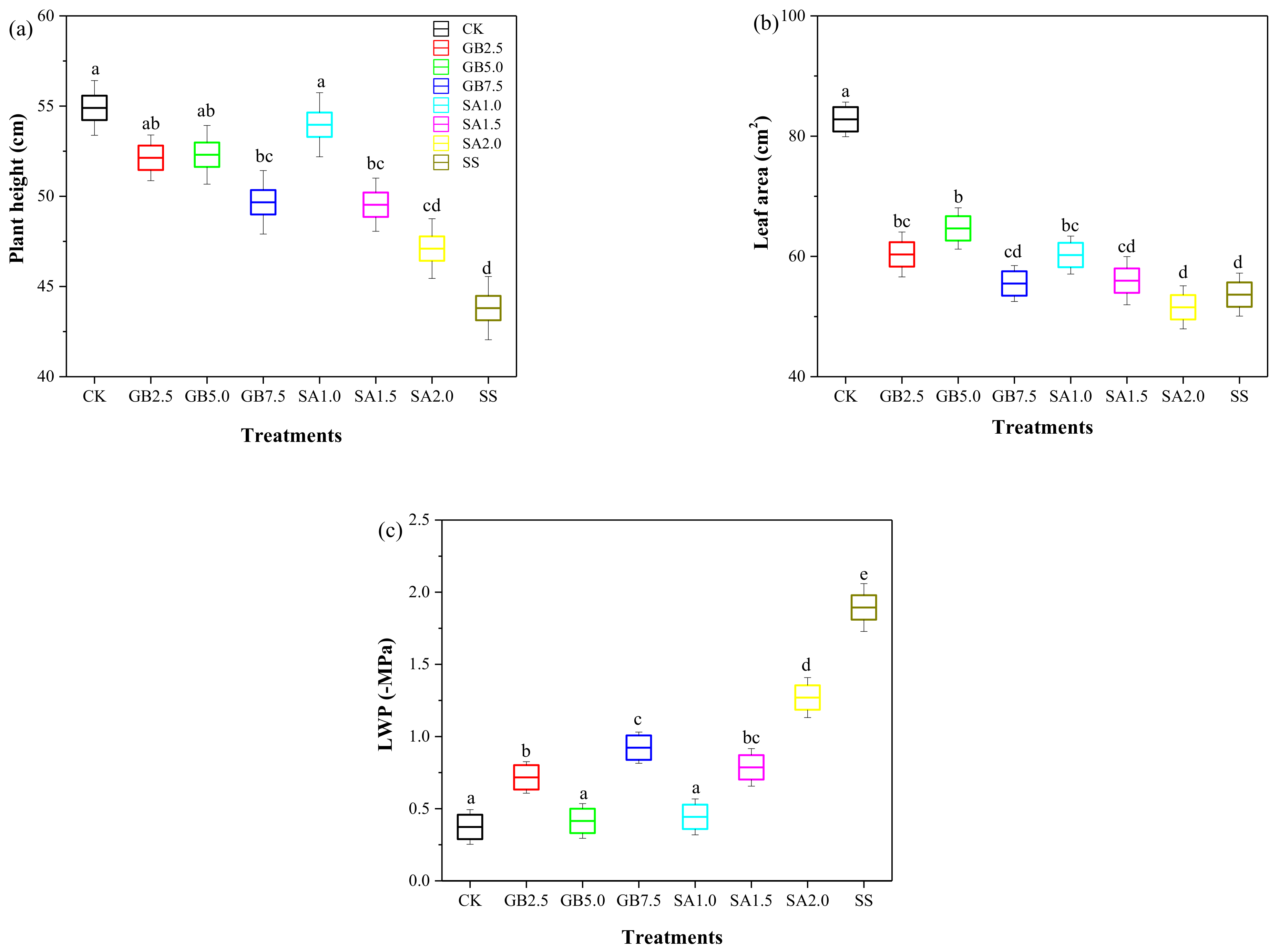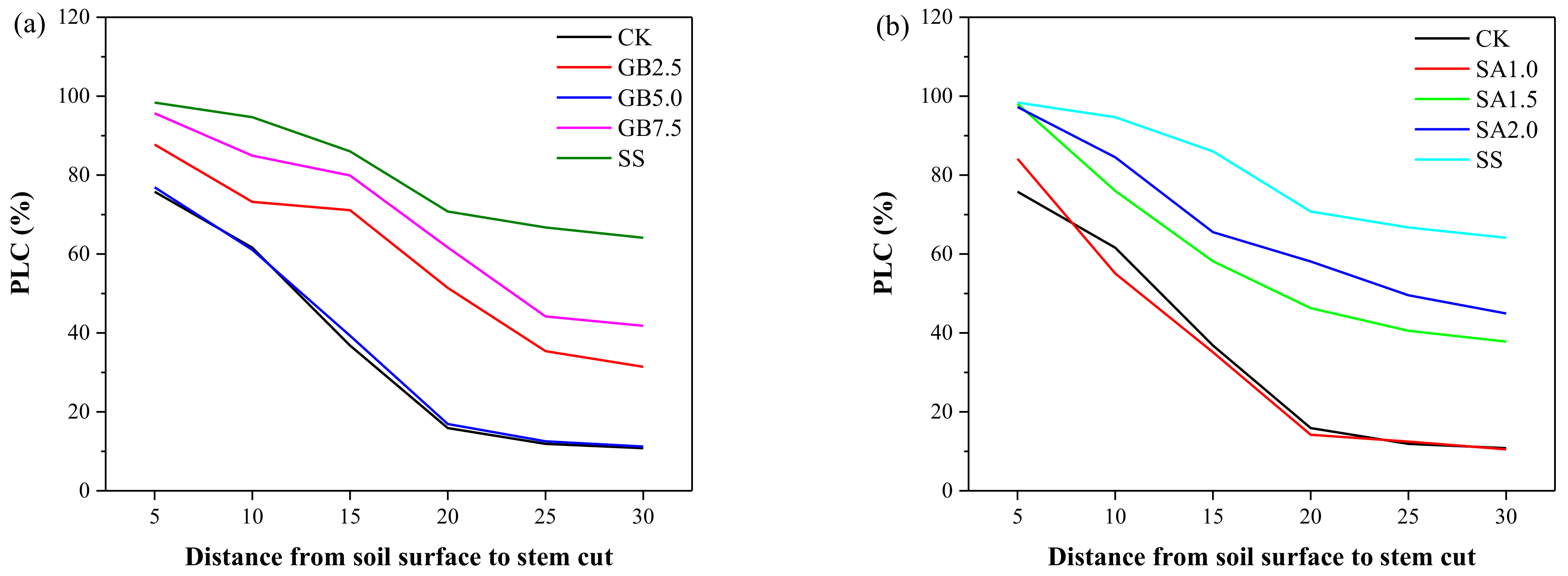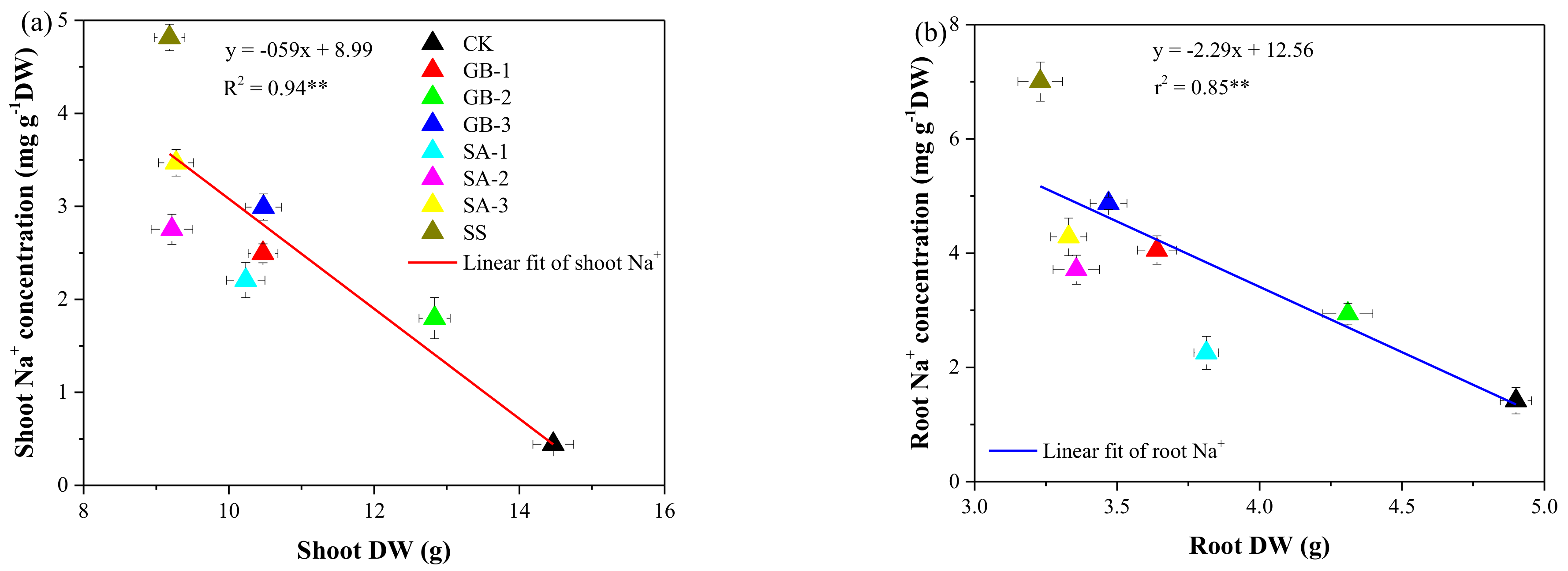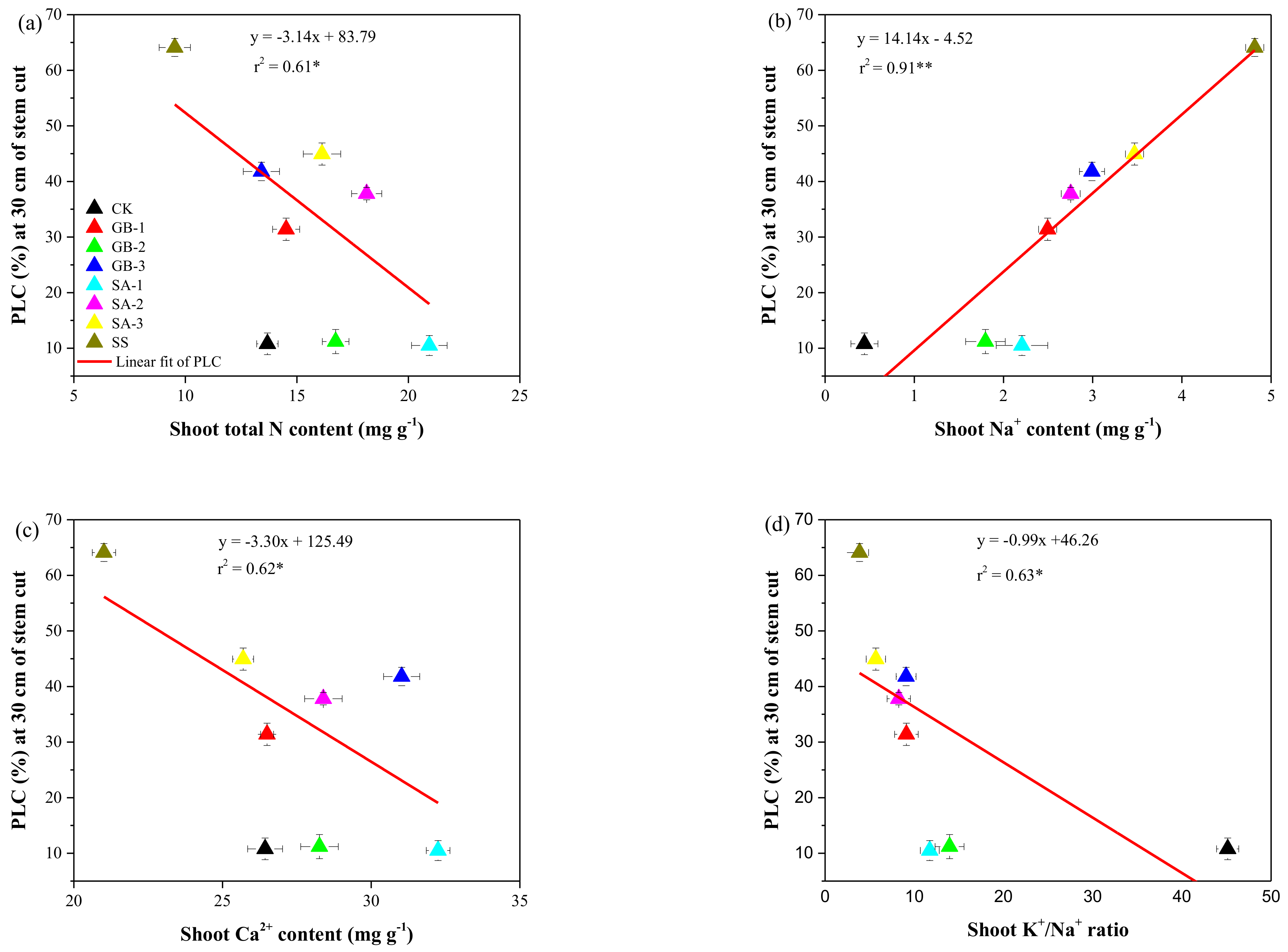Application of Exogenous Protectants Mitigates Salt-Induced Na+ Toxicity and Sustains Cotton (Gossypium hirsutum L.) Seedling Growth: Comparison of Glycine Betaine and Salicylic Acid
Abstract
1. Introduction
2. Results
2.1. Effect of Exogenous GB and SA on Cotton Seedling Growth and Nitrogen Accumulation
2.2. Effect of Exogenous GB and SA on the PLC
2.3. Effect of Exogenous GB and SA on Ion Concentrations in the Shoot and Roots of Seedlings
2.4. Relationship between PLC and Shoot Nutrients
3. Discussion
4. Materials and Methods
4.1. Experimental Material
4.2. Determination of Plant Growth Parameters, pH, and EC
4.3. Determination of the Nutrient Content
4.4. Statistical Analysis
5. Conclusions
Author Contributions
Funding
Acknowledgments
Conflicts of Interest
References
- Muchate, N.S.; Nikalje, G.C.; Rajurkar, N.S.; Suprasanna, P.; Nikam, T.D. Plant Salt Stress: Adaptive Responses, Tolerance Mechanism and Bioengineering for Salt Tolerance. Bot. Rev. 2016, 82, 371–406. [Google Scholar] [CrossRef]
- Khalifa, G.S.; Abdelrassoul, M.; Hegazi, A.M.; Elsherif, M.H. Attenuation of Negative Effects of Saline Stress in two Lettuce Cultivars by Salicylic Acid and Glycine Betaine. Gesunde Pflanz. 2016, 68, 177–189. [Google Scholar] [CrossRef]
- Dong, Y.J.; Jinc, S.S.; Liu, S.; Xu, L.L.; Kong, J. Effects of exogenous nitric oxide on growth of cotton seedlings under NaCl stress. J. Soil Sci. Plant Nutr. 2014, 14, 1–13. [Google Scholar] [CrossRef][Green Version]
- Mudgal, A.; Madaan, N.; Mudgal, A. Biochemical Mechanisms of Salt Tolerance in Plants: A Review. Int. J. Bot. 2010, 6, 136–143. [Google Scholar] [CrossRef]
- Yildirim, E.; Ekinci, M.; Turan, M.; Dursun, A.; Kul, R.; Parlakova, F. Roles of glycine betaine in mitigating deleterious effect of salt stress on lettuce (Lactuca sativa L.). Arch. Agron. Soil Sci. 2015, 61, 1673–1689. [Google Scholar] [CrossRef]
- Meloni, D.A.; Oliva, M.A.; Ruiz, H.A.; Martinez, C.A. Contribution of proline and inorganic solutes to osmotic adjustment in cotton under salt stress. J. Plant Nutr. 2001, 24, 599–612. [Google Scholar] [CrossRef]
- Ashraf, M.; Foolad, M.R. Roles of glycine betaine and proline in improving plant abiotic stress resistance. Environ. Exp. Bot. 2007, 59, 206–216. [Google Scholar] [CrossRef]
- Kurepin, L.V.; Ivanov, A.G.; Zaman, M.; Pharis, R.P.; Allakhverdiev, S.I.; Hurry, V.; Hüner, N.P.A. Stress-related hormones and glycinebetaine interplay in protection of photosynthesis under abiotic stress conditions. Photosynth. Res. 2015, 126, 221–235. [Google Scholar] [CrossRef]
- Hamdia, M.A.; Shaddad, M.A.K. Salt tolerance of crop plants. J. Stress Physiol. Biochem. 2010, 6, 64–90. [Google Scholar]
- Cuin, T.A.; Shabala, S. Exogenously Supplied Compatible Solutes Rapidly Ameliorate NaCl-induced Potassium Efflux from Barley Roots. Plant Cell Physiol. 2005, 46, 1924–1933. [Google Scholar] [CrossRef]
- Rahman, M.S.; Miyake, H.; Takeoka, Y. Effects of Exogenous Glycinebetaine on Growth and Ultrastructure of Salt-Stressed Rice Seedlings (Oryza sativa L.). Plant Prod. Sci. 2002, 5, 33–44. [Google Scholar] [CrossRef]
- Nazar, R.; Iqbal, N.; Syeed, S.; Khan, N.A. Salicylic acid alleviates decreases in photosynthesis under salt stress by enhancing nitrogen and sulfur assimilation and antioxidant metabolism differentially in two mungbean cultivars. J. Plant Physiol. 2011, 168, 807–815. [Google Scholar] [CrossRef]
- Karlidag, H.; Yildirim, E.; Turan, M. Salicylic acid ameliorates the adverse effect of salt stress on strawberry. Sci. Agric. 2009, 66, 180–187. [Google Scholar] [CrossRef]
- Navarro, A.; Bañon, S.; Olmos, E.; Sánchez-Blanco, M.J. Effects of sodium chloride on water potential components, hydraulic conductivity, gas exchange and leaf ultrastructure of Arbutus unedo plants. Plant Sci. 2007, 172, 473–480. [Google Scholar] [CrossRef]
- Ashraf, M.; Ahmad, S. Influence of sodium chloride on ion accumulation, yield components and fibre characteristics in salt-tolerant and salt-sensitive lines of cotton (Gossypium hirsutum L.). Field Crop. Res. 2000, 66, 115–127. [Google Scholar] [CrossRef]
- Higbie, S.M.; Wang, F.; Stewart, J.M.; Sterling, T.M.; Lindemann, W.C.; Hughs, E.; Zhang, J. Physiological Response to Salt (NaCl) Stress in Selected Cultivated Tetraploid Cottons. Int. J. Agron. 2010, 2010, 643475. [Google Scholar] [CrossRef]
- Ram, P.; Garg, O.; Singh, B.; Maurya, B. Effect of salt stress on nodulation fixed nitrogen partitioning and yield attributes in chickpea (Cicer arietinum L.). Indian J. Plant Physiol. 1989, 32, 115–121. [Google Scholar]
- Liu, W.; Zhang, Y.; Yuan, X.; Xuan, Y.; Gao, Y.; Yan, Y. Exogenous salicylic acid improves salinity tolerance of Nitraria tangutorum. Russ. J. Plant Physiol. 2016, 63, 132–142. [Google Scholar] [CrossRef]
- Khan, M.I.R.; Asgher, M.; Khan, N.A. Alleviation of salt-induced photosynthesis and growth inhibition by salicylic acid involves glycinebetaine and ethylene in mungbean (Vigna radiata L.). Plant Physiol. Biochem. 2014, 80, 67–74. [Google Scholar] [CrossRef]
- Munns, R. Genes and salt tolerance: Bringing them together. New Phytol. 2005, 167, 645–663. [Google Scholar] [CrossRef]
- Lutts, S. Exogenous glycinebetaine reduces sodium accumulation in salt-stressed rice plants. Int. Rice Res. Notes 2000, 25, 39–40. [Google Scholar]
- Essa, T. Effect of salinity stress on growth and nutrient composition of three soybean (Glycine max L. Merrill) cultivars. J. Agron. Crop Sci. 2002, 188, 86–93. [Google Scholar] [CrossRef]
- El-Tayeb, M. Response of barley grains to the interactive e. ect of salinity and salicylic acid. Plant Growth Regul. 2005, 45, 215–224. [Google Scholar] [CrossRef]
- Gunes, A.; Inal, A.; Alpaslan, M.; Eraslan, F.; Bagci, E.G.; Cicek, N. Salicylic acid induced changes on some physiological parameters symptomatic for oxidative stress and mineral nutrition in maize (Zea mays L.) grown under salinity. J. Plant Physiol. 2007, 164, 728–736. [Google Scholar] [CrossRef]
- Yildirim, E.; Turan, M.; Guvenc, I. Effect of foliar salicylic acid applications on growth, chlorophyll, and mineral content of cucumber grown under salt stress. J. Plant Nutr. 2008, 31, 593–612. [Google Scholar] [CrossRef]
- Abbas, W.; Ashraf, M.; Akram, N.A. Alleviation of salt-induced adverse effects in eggplant (Solanum melongena L.) by glycinebetaine and sugarbeet extracts. Sci. Hortic. 2010, 125, 188–195. [Google Scholar] [CrossRef]
- Habib, N.; Ashraf, M.; Ali, Q.; Perveen, R. Response of salt stressed okra (Abelmoschus esculentus Moench) plants to foliar-applied glycine betaine and glycine betaine containing sugarbeet extract. S. Afr. J. Bot. 2012, 83, 151–158. [Google Scholar] [CrossRef]
- Gadallah, M. Effects of proline and glycinebetaine on Vicia faba responses to salt stress. Biol. Plant. 1999, 42, 249–257. [Google Scholar] [CrossRef]
- El-Beltagi, H.S.; Ahmed, S.H.; Namich, A.A.M.; Abdel-Sattar, R.R. Effect of salicylic acid and potassium citrate on cotton plant under salt stress. Fresen. Environ. Bull 2017, 26, 1091–1100. [Google Scholar]
- Heuer, B. Influence of exogenous application of proline and glycinebetaine on growth of salt-stressed tomato plants. Plant Sci. 2003, 165, 693–699. [Google Scholar] [CrossRef]
- Ahmed, A.H.; Darwish, E.; Hamoda, S.; Alobaidy, M. Effect of putrescine and humic acid on growth, yield and chemical composition of cotton plants grown under saline soil conditions. Am. Eurasian J. Agric. Environ. Sci. 2013, 13, 479–497. [Google Scholar]
- Hayat, Q.; Hayat, S.; Irfan, M.; Ahmad, A. Effect of exogenous salicylic acid under changing environment: A review. Environ. Exp. Bot. 2010, 68, 14–25. [Google Scholar] [CrossRef]
- Arfan, M.; Athar, H.R.; Ashraf, M. Does exogenous application of salicylic acid through the rooting medium modulate growth and photosynthetic capacity in two differently adapted spring wheat cultivars under salt stress? J. Plant Physiol. 2007, 164, 685–694. [Google Scholar] [CrossRef]
- He, Y.; Liu, Y.; Cao, W.; Huai, M.; Xu, B.; Huang, B. Effects of salicylic acid on heat tolerance associated with antioxidant metabolism in Kentucky bluegrass. Crop Sci. 2005, 45, 988–995. [Google Scholar] [CrossRef]
- Youssef, S.M.; Elhady, S.A.A.; Aref, R.M.; Riad, G.S. Salicylic acid attenuates the adverse effects of salinity on growth and yield and enhances peroxidase isozymes expression more competently than proline and glycine betaine in cucumber plants. Gesunde Pflanz. 2018, 70, 75–90. [Google Scholar] [CrossRef]
- Rajput, V.D.; Yaning, C.; Ayup, M.; Minkina, T.; Sushkova, S.; Mandzhieva, S. Physiological and hydrological changes in Populus euphratica seedlings under salinity stress. Acta Ecol. Sin. 2017, 37, 229–235. [Google Scholar] [CrossRef]
- Hamani, A.K.M.; Wang, G.; Soothar, M.K.; Shen, X.; Gao, Y.; Qiu, R.; Mehmood, F. Responses of leaf gas exchange attributes, photosynthetic pigments and antioxidant enzymes in NaCl-stressed cotton (Gossypium hirsutum L.) seedlings to exogenous glycine betaine and salicylic acid. BMC Plant Biol. 2020, 20, 1–14. [Google Scholar] [CrossRef] [PubMed]
- Chen, T.H.; Murata, N. Enhancement of tolerance of abiotic stress by metabolic engineering of betaines and other compatible solutes. Curr. Opin. Plant Biol. 2002, 5, 250–257. [Google Scholar] [CrossRef]
- Chen, T.H.; Murata, N. Glycinebetaine: An effective protectant against abiotic stress in plants. Trends Plant Sci. 2008, 13, 499–505. [Google Scholar] [CrossRef]
- Pál, M.; Szalai, G.; Kovács, V.; Gondor, O.; Janda, T. Salicylic Acid-Mediated Abiotic Stress Tolerance. In Salicylic Acid; Springer: Berlin/Heidelberg, Germany, 2013; pp. 183–247. [Google Scholar]
- Hu, L.; Hu, T.; Zhang, X.; Pang, H.; Fu, J. Exogenous glycine betaine ameliorates the adverse effect of salt stress on perennial ryegrass. J. Am. Soc. Hortic. Sci. 2012, 137, 38–46. [Google Scholar] [CrossRef]
- Raza, S.H.; Athar, H.R.; Ashraf, M.; Hameed, A. Glycinebetaine-induced modulation of antioxidant enzymes activities and ion accumulation in two wheat cultivars differing in salt tolerance. Environ. Exp. Bot. 2007, 60, 368–376. [Google Scholar] [CrossRef]
- Heeg, C.; Kruse, C.; Jost, R.; Gutensohn, M.; Ruppert, T.; Wirtz, M.; Hell, R. Analysis of the Arabidopsis O-acetylserine (thiol) lyase gene family demonstrates compartment-specific differences in the regulation of cysteine synthesis. Plant Cell 2008, 20, 168–185. [Google Scholar] [CrossRef] [PubMed]
- Qiu, R.; Liu, C.; Wang, Z.; Yang, Z.; Jing, Y. Effects of irrigation water salinity on evapotranspiration modified by leaching fractions in hot pepper plants. Sci. Rep. 2017, 7, 1–11. [Google Scholar] [CrossRef][Green Version]
- Qiu, R.; Yang, Z.; Jing, Y.; Liu, C.; Luo, X.; Wang, Z. Effects of irrigation water salinity on the growth, gas exchange parameters, and ion concentration of hot pepper plants modified by leaching fractions. HortScience 2018, 53, 1050–1055. [Google Scholar] [CrossRef]
- Wang, C.; Wu, S.; Tankari, M.; Zhang, X.; Li, L.; Gong, D.; Hao, W.; Zhang, Y.; Mei, X.; Wang, Y. Stomatal aperture rather than nitrogen nutrition determined water use efficiency of tomato plants under nitrogen fertigation. Agric. Water Manag. 2018, 209, 94–101. [Google Scholar] [CrossRef]
- Ewers, F.W.; Lopez-Portillo, J.; Angeles, G.; Fisher, J.B. Hydraulic conductivity and embolism in the mangrove tree Laguncularia racemosa. Tree Physiol. 2004, 24, 1057–1062. [Google Scholar] [CrossRef]
- Nelson, D.W.; Sommers, L. Determination of total nitrogen in plant material 1. Agron. J. 1973, 65, 109–112. [Google Scholar] [CrossRef]
- Xu, C.-X.; Liu, Y.-L.; Zheng, Q.-S.; Liu, Z.-P. Silicate improves growth and ion absorption and distribution in aloe vera under salt stress. J. Plant Physiol. Mol. Biol. 2006, 32, 73–78. [Google Scholar]
- Rajakaruna, N.; Siddiqi, M.Y.; Whitton, J.; Bohm, B.A.; Glass, A.D. Differential responses to Na+/K+ and Ca2+/Mg2+ in two edaphic races of the Lasthenia californica (Asteraceae) complex: A case for parallel evolution of physiological traits. New Phytol. 2003, 157, 93–103. [Google Scholar] [CrossRef]






| Treatments | Shoot Ion Concentrations (mg × g−1 Dry Weight) | Ratios | ||||
|---|---|---|---|---|---|---|
| K+ | Na+ | Ca2+ | Mg2+ | K+/Na+ | Ca2+/Mg2+ | |
| CK | 19.91 ± 0.28 e | 0.44 ± 0.02 g | 26.43 ± 0.59 d | 3.86 ± 0.40 b,c | 45.13 ± 1.25 a | 6.88 ± 0.56 a,b |
| GB2.5 | 22.73 ± 0.12 d | 2.49 ± 0.01 d | 26.49 ± 022 d | 3.80 ± 0.43 b,c | 9.11 ± 0.32 d | 7.88 ± 1.13 a |
| GB5.0 | 25.08 ± 0.43 c | 1.79 0.22 f | 28.26 ± 0.63 c | 4.07 ± 0.02 b | 13.95 ± 0.62 b | 6.93 ± 0.18 a,b |
| GB7.5 | 27.19 ± 0.21 a | 2.99 ± 0.04 c | 31.02 ± 0.61 b | 4.99 ± 0.03 a | 9.08 ± 0.12 d | 6.21 ± 0.09 b |
| SA1.0 | 25.88 ± 0.88 b | 2.20 ± 0.29 e | 32.25 ± 0.40 a | 5.16 ± 0.40 a | 11.73 ± 0.06 c | 6.26 ± 0.41 b |
| SA1.5 | 22.74 ± 0.13 d | 2.75 ± 0.11 c | 28.39 ± 0.63 c | 4.04 ± 0.01 b | 8.26 ± 0.31 d | 7.02 ± 0.14 a,b |
| SA2.0 | 19.74 ± 0.01 e | 3.46 ± 0.01 b | 25.69 ± 0.15 d | 3.81 ± 0.08 b,c | 5.69 ± 0.09 e | 6.73 ± 0.10 b |
| SS | 18.59 ± 0.12 f | 4.81 ± 0.10 a | 21.01 ± 0.39 e | 2.94 ± 0.50 d | 3.86 ± 0.02 f | 7.27 ± 1.23 a,b |
| Treatments | Root Ions Concentrations (mg × g−1 Dry Weight) | Ratios | ||||
|---|---|---|---|---|---|---|
| K+ | Na+ | Ca2+ | Mg2+ | K+/Na+ | Ca2+/Mg2+ | |
| CK | 17.64 ± 0.55 c | 1.41 ± 0.03 g | 7.21 ± 0.21 d | 3.85 ± 0.13 a,b | 12.43 ± 0.92 a | 1.87 ± 0.11 e |
| GB2.5 | 18.39 ± 0.24 b | 4.05 ± 0.05 c,d | 7.67 ± 0.69 d | 2.24 ± 0.01 d | 4.53 ± 0.32 d | 3.42 ± 0.31 b |
| GB5.0 | 18.75 ± 0.26 b | 2.94 ± 0.58 e | 8.22 ± 0.59 c | 3.12 ± 0.01 c | 6.37 ± 0.61 c | 2.63 ± 0.18 c,d |
| GB7.5 | 21.72 ± 0.18 a | 4.87 ± 0.11 b | 8.83 ± 1.01 b | 3.54 ± 0.11 b | 4.45 ± 0.21 d | 2.49 ± 0.20 c,d |
| SA1.0 | 21.70 ± 0.63 a | 2.25 ± 0.29 f | 9.41 ± 0.10 a | 4.13 ± 0.34 a | 9.63 ± 0.64 b | 2.29 ± 0.17 d |
| SA1.5 | 18.51±0.27 b | 3.71±0.25 d | 8.88±0.24 c | 3.62±0.50 b | 4.99±0.86 d | 2.48±0.27 c,d |
| SA2.0 | 17.56±0.56 c | 4.28±0.33 c | 8.29±0.29 d | 3.11±0.02 c | 4.09±0.45 d | 2.66±0.09 c |
| SS | 16.77±0.18 d | 7.00±0.34 a | 6.84±0.28 e | 1.80±0.15 e | 2.39±0.11 e | 2.79±0.15 a |
| Soil Conditions | pH | EC (dS m−1) |
|---|---|---|
| Initial soil | 8.12 | 0.53 |
| At 150 mM NaCl application | 8.18 | 5.42 |
| After harvesting | 8.56 | 5.46 |
| Treatment Label | NaCl Dose (mM) | GB Dose (mM) | SA Dose (mM) |
|---|---|---|---|
| CK | - | - | - |
| GB2.5 | 150 | 2.5 | - |
| GB5.0 | 150 | 5.0 | - |
| GB7.5 | 150 | 7.5 | - |
| SA1.0 | 150 | - | 1.0 |
| SA1.5 | 150 | - | 1.5 |
| SA2.0 | 150 | - | 2.0 |
| SS | 150 | - | - |
Publisher’s Note: MDPI stays neutral with regard to jurisdictional claims in published maps and institutional affiliations. |
© 2021 by the authors. Licensee MDPI, Basel, Switzerland. This article is an open access article distributed under the terms and conditions of the Creative Commons Attribution (CC BY) license (http://creativecommons.org/licenses/by/4.0/).
Share and Cite
Hamani, A.K.M.; Chen, J.; Soothar, M.K.; Wang, G.; Shen, X.; Gao, Y.; Qiu, R. Application of Exogenous Protectants Mitigates Salt-Induced Na+ Toxicity and Sustains Cotton (Gossypium hirsutum L.) Seedling Growth: Comparison of Glycine Betaine and Salicylic Acid. Plants 2021, 10, 380. https://doi.org/10.3390/plants10020380
Hamani AKM, Chen J, Soothar MK, Wang G, Shen X, Gao Y, Qiu R. Application of Exogenous Protectants Mitigates Salt-Induced Na+ Toxicity and Sustains Cotton (Gossypium hirsutum L.) Seedling Growth: Comparison of Glycine Betaine and Salicylic Acid. Plants. 2021; 10(2):380. https://doi.org/10.3390/plants10020380
Chicago/Turabian StyleHamani, Abdoul Kader Mounkaila, Jinsai Chen, Mukesh Kumar Soothar, Guangshuai Wang, Xiaojun Shen, Yang Gao, and Ranjian Qiu. 2021. "Application of Exogenous Protectants Mitigates Salt-Induced Na+ Toxicity and Sustains Cotton (Gossypium hirsutum L.) Seedling Growth: Comparison of Glycine Betaine and Salicylic Acid" Plants 10, no. 2: 380. https://doi.org/10.3390/plants10020380
APA StyleHamani, A. K. M., Chen, J., Soothar, M. K., Wang, G., Shen, X., Gao, Y., & Qiu, R. (2021). Application of Exogenous Protectants Mitigates Salt-Induced Na+ Toxicity and Sustains Cotton (Gossypium hirsutum L.) Seedling Growth: Comparison of Glycine Betaine and Salicylic Acid. Plants, 10(2), 380. https://doi.org/10.3390/plants10020380












